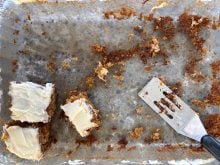Like many other farm families, we are about to be transplanted. We are moving to town and our son Bob and his family are moving to the farm.
It will be a new experience for us. We used to live in the city for the winters, but were always ready to get back to the farm come spring. The farm has always been home. It will also be an adjustment for Pam, our daughter-in-law, who has never lived on a farm.
Over the years we have seen neighbors struggle while deciding where to retire. Common options are to move to the city, a big town not too far away, a small town close by, or to build another house on the farm. When our moment of decision arrived, it lasted several years before we settled on moving to the small town only 10 minutes away.
Read Also

VIDEO: Bittersweet harvest for this family farmhand
Bruce Burnett helps his brother harvest wheat and canola for the last time on the family farm in Manitoba where they both grew up.
Community activities can carry on as before, while Bob, Pam, the grandchildren and the farm will be close by. The transplanting won’t be as hard on our system as it would if we moved far away.
I take solace in Lois Hole’s description of transplanting, in her book I’ll Never Marry A Farmer. She writes: “Have you ever been in a garden centre and seen those long, lanky tomato seedlings that have obviously outgrown their containers? They look so funny, don’t they? Sort of like gangly adolescents, with their limbs all over the place. People can be like that too sometimes. Once we put down roots, we get comfortable in our little spaces. We don’t want to pick up and try something different – it’s so much easier to stay where we are.
“But like those overgrown seedlings, we can thrive in a new location, with a new challenge. If we don’t transplant from time to time, we stunt ourselves. We need to change to keep growing stronger and better.”
I haven’t been transplanted for 38 years, so I guess it is time.
Deep-fried doughnuts
E.W. of Gerald, Sask., requested a yeast doughnut recipe and information on what makes the dough absorb more or less fat when frying.
We can to some extent control the amount of fat absorbed by food during deep-fat frying.
While this type of cooking does supply more fat than most of us need, on occasion we do like to make our own doughnuts, fries, egg rolls or fritters. As our community rinks open another season, many of us will be using deep fat-fryers there. But our rink kitchens should offer a variety of healthier food choices.
The following tips will help decrease fat absorption when deep-frying:
- Maintain a frying temperature of 190 C (375 F) to cook the food quickly. If the oil is not hot enough, it will soak into the food before it cooks. The longer the food cooks, the greater the absorption of fat.
- Coating the food with a batter or crumbs prevents the absorption of fat. The coating cooks quickly and forms a protective shield. The food under the coating will then cook by conduction or indirect heat.
- If the oil is too hot, the coating will burn before the food has had time to cook. Also, overheating the oil causes it to break down. Decomposition occurs every time the oil is allowed to smoke.
- Avoid crowding the deep-fryer with food because it will lower the oil’s temperature, thus taking longer to cook the food. For each volume of food, use at least six volumes of oil.
- Fry vegetable foods, like potato chips, while they are still frozen to limit fat absorption.
- To keep the temperature high, use an oil with a high smoke point. The smoke point of an oil is the temperature at which the oil begins to decompose and smoke is released. Most vegetable oils have higher smoke points than animal fats.
Ingredient Smoke point
temperature
Safflower 265 C
Sunflower 246 C
Soybean 241 C
Canola 238 C
Corn 236 C
Peanut 231 C
Sesame 215 C
Olive 190 C
Lards 183-205 C
Source: Canola Information Service
Canola oil is a good choice because it has a high smoke point, is grown on the Prairies, has the lowest percentage of saturated fat of all the oils listed previously, and is tasteless, light and clear, allowing the flavor of other foods to dominate. Research indicates that canola drains more thoroughly than melted shortening, leaving foods five to 10 percent lower in calories than the same foods fried in melted shortening.
An oil’s smoke point is lowered by several factors.
- Frequency of use.
- Presence of foreign material such as batter or crumbs. Shake off loosely attached bread crumbs from breaded food before adding the food to the oil. Use a small strainer or slotted spoon to remove as many crumbs as possible. Strain cooled oil before reusing.
- Salt breaks down oil. If required, add salt just before eating. Also, the salt draws moisture to the food’s surface, which will splatter when the food is added to the hot oil.
- The longer oil is heated, the more quickly it will decompose. Avoid preheating the oil any longer than necessary. Add each new batch quickly if more than one batch is being cooked, unless time is needed to adjust the cooking temperature. Turn off the heat as soon as the last batch is cooked.
For more information about using canola oil, contact the Canola Information Service, Box 1645, Lloydminster, Sask., S9V 1K6, 306-387-6610, fax 306-387-6637, canola @sk.sympatico.ca, www.canolainfo.org.
Yeast doughnuts
2 tablespoons, two 30 mL
envelopes granular yeast
1Ú2 cup warm water 125 mL
1 teaspoon sugar 5 mL
1Ú2 cup butter or 125 mL
margarine
3 cups water 750 mL
3Ú4 cup sugar 175 mL
1 teaspoon salt 5 mL
2 eggs, beaten
4-5 cups flour 1-1.25 L
Stir one teaspoon (five mL) sugar into the lukewarm water. Sprinkle with yeast and let stand 10 minutes without stirring.
Mix butter or margarine, water, sugar and salt. Bring to a lukewarm temperature by heating on the stove or in a microwave.
Add the beaten eggs and yeast mixture. Add enough flour for a soft dough so that it sticks slightly to hands. Knead.
Cover and let rise in a warm place until double in bulk, about 45 to 60 minutes.
Roll dough to a thickness of about 1Ú2 inch or one centimetre. Cut into doughnuts. Place on a floured cookie sheet and let rise until almost double in height, about 45 minutes.
Heat fat to 375 F (190 C). Drop dough into hot fat and fry until brown; turn and brown on the other side.
Drain. Sprinkle with sugar or glaze while doughnuts are warm.
Yield: 40-45 doughnuts.
Glaze:
1Ú2 cup butter or 125 mL
margarine
1 cup white sugar 250 mL
1Ú2 cup milk 125 mL
1 cup (approx.) 250 mL
icing sugar
Boil butter or margarine, sugar and milk for 1 1Ú2 minutes. Cool and add icing sugar until the right thickness for spreading.
Halloween dessert
This year Halloween falls on a Sunday. This orange and black colored cheesecake is a tasty dinner dessert. It has become an annual Halloween dessert at our house since we discovered it a few years ago.
Crust:
2 cups chocolate 500 mL
wafer crumbs
1Ú4 cup sugar 50 mL
1Ú2 cup butter or 125 mL
margarine
Mix chocolate wafer crumbs, sugar and butter or margarine. Press firmly onto bottom of a 13 x 9 inch (22 x 33 cm) pan. Refrigerate.
First layer:
1 package(8 oz.) cream 250 g
cheese, softened
1Ú4 cup sugar 50 mL
1Ú2 tub (12 oz.) 1 L
whipped topping
Beat cream cheese and sugar until smooth. Stir in whipped topping. Spread over the crust.
Second layer:
1 package (6 oz.) 170 g
orange flavor gelatin
2 cups boiling water 500 mL
1Ú2 cup cold water 125 mL
ice cubes
Pour boiling water into gelatin and stir until dissolved. Mix cold water and ice to make 11Ú2 cups (375 mL). Stir into gelatin until slightly thickened. Remove any remaining ice. Pour over cream cheese layer. Refrigerate three hours or until firm.
Third layer:
Spread remaining 1Ú2 tub of whipped topping over gelatin. Sprinkle with chocolate wafer crumbs.
















